
Archives & Manuscripts Costumes & Textiles Daguerreotypes & Photographs Decorative Arts Fine Art Other Collections Furniture Digital Collections 
|


Crazy Quilt, 1884
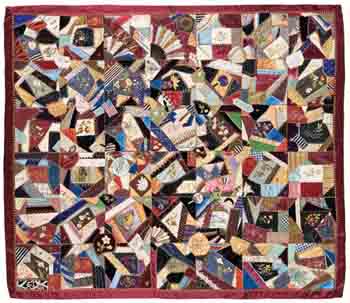 |
Quilt made by Henrietta Bryan Lambie, 1884 David Stansbury photograph Courtesy of the Massachusetts Quilt Documentation Project |
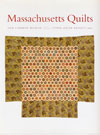 |
This 1884 quilt made by Henrietta Bryan Lambie (1852-1932) memorializes Henrietta’s two young daughters, Ethel Henrietta (1879-1884) and Emily Mary (1882-1884). The quilt was featured in the book Massachusetts Quilts: Our Common Wealth (University Press of New England, 2009). Costume and textile historian Lynne Zacek Bassett of the Massachusetts Quilt Documentation Project wrote this description of its history and symbolism.
Viewed without an awareness of its history, the grief that this crazy quilt symbolizes is not immediately apparent. Made of typical late nineteenth-century silks and velvets, it is embellished with the Japanese-inspired motifs of handscreens, lotus flowers, and Oriental vases that one usually finds on such quilts. Careful study, however, reveals a story: painted and embroidered pansises, representing “thoughts” or sympathy in the Victorian language of flowers, daisies, representing childhood’s innocence, embroidered along with the name “Ethel”; forget-me-nots painted on cream satin; multiple embroidered motifs of children; and a hen with her chicks all suggest a mother’s loss of a child. In fact, two children are commemorated in this quilt.
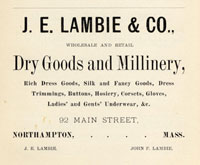 |
Advertisement for J. E. Lambie & Co., Northampton and Easthampton Business Directory, 1891-92 |
In 1875, Henrietta Bryan of New York City married Jasper Eadie Lambie (1845-1898) of Easthampton, Massachusetts. Jasper and his brother John were the prosperous owners of a dry goods shop on Main Street in Northampton. J. E. Lambie & Co. advertisements in the Northampton City Directories of the 1880s and 1890s reveal that they offered “Rich Dress Goods, Silk and Fancy Goods, Dress Trimmings, Buttons, Hosiery, Corsets, Gloves, Ladies’ and Gents’ Underwear, &c.” Henrietta and Jasper spent the first ten years of their marriage in nearby Easthampton. In 1879, Ethel Henrietta was born. Another daughter, Emily Mary, came along in 1882. Grief came to the family in 1884 when five-year-old Ethel died in February. Because one block in the quilt is dated April 30, 1884, it seems that the quilt began as a memorial to Ethel, but when two-year-old Emily died in August that same year, the quilt became her memorial as well.
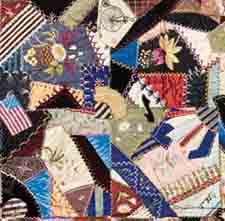 |
In copperplate script, Henrietta wrote a note to keep with the quilt, describing the fabrics she used. Her husband’s ties are the black and white and purple silks – all colors of mourning. Ethel’s pink sash and red and blue ribbons are used, along with the white silk lining to Emily’s cloak, which Henrietta painted with forget-me-nots. Much of the rest of the quilt was made from pieces of Henrietta’s own clothing, to which she added “the red satin … to brighten.” Henrietta and Jasper’s daughter Margaret, born in 1885, noted when she donated the quilt to Historic Northampton that “sympathetic friends” also contributed blocks for the quilt, which explains the various initials and names such as “Davis” and “Newman” that appear on the quilt.
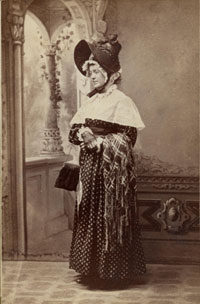 |
Henrietta Bryan Lambie dressed in 1830s costume for a pageant, circa 1890s |
Henrietta Lambie’s declaration in the 1900 Federal Census that she was the mother of six children, along with the span of four years from her wedding date to the birth of Ethel, suggests that she lost two babies in the first years of her marriage. Perhaps in part to escape the sad memories of their losses in Easthampton, in 1885 the couple moved to Northampton. Two more children were born: Margaret, who became a prominent lawyer in Washington, D.C., and Morris (b. 1888), who also survived to adulthood and became a professor at the University of Minnesota. Henrietta suffered one more grievous loss when Jasper died in 1898. The dry goods business continued under the supervision of her brother-in-law into the 1920s, probably providing some income to Henrietta, as she appears to have continued to live comfortably in Northampton. She was active in the community, participating in Colonial Revival pageants and lending her beautiful contralto voice to church choirs throughout the vicinity. In 1914, Henrietta and her two surviving children moved to New York City to join Henrietta’s family. In her old age, Henrietta lived with Margaret in Washington, D.C., where she died at age eighty.
Contents Historic Northampton.